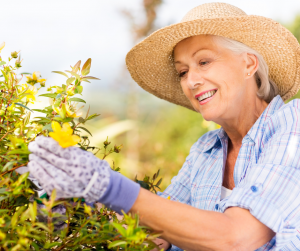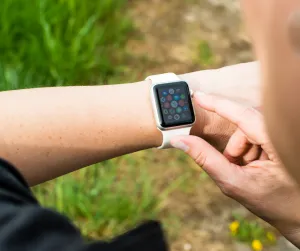5 Fantastic Reasons to Wear an Apple Watch for Fall Detection
Many seniors felt traditional fall alert systems were stigmatizing, but now that you can use an Apple Watch for fall detection, that's hardly a concern. If anything, people will think you're keeping up with the younger generation!
Devices have grown more stylish, but that isn't the only improvement. Technology advancements have led to notable developments in the performance and features of fall detection devices. Traditional devices, such as the Life Call system, required the wearer to push a button to get help. That's all well and good if you have the ability to press a button. However, if a stroke, head trauma, or some other injury leaves you incapacitated, it's far less helpful. Further, devices only worked inside the home, limiting their usefulness.
Today's devices are far more advanced. They offer features such as Automatic Fall Detection and work anywhere you have cellular coverage. If you get the right cellular plan for your Apple Watch, you can use your Apple Watch for fall detection even if you are out of your phone's Bluetooth range. (This does vary by plan, so be sure to discuss this with your cellular provider).
Not an Apple person, or feel the Apple Watch is too complicated? No worries. The technology spillover is showing up in all sorts of terrific devices geared more specifically toward safety. Products available from FallCall, Medical Guardian, and UnaliWear Home could suit your needs admirably. In addition to watches, some of these companies make simple pendants embedded in stylish jewelry. This option can be perfect for the senior who wants a simple, unobtrusive solution.
Before we get started, there are a few caveats to note. We've already discussed the fact that it is important to understand if your Apple Watch works without a cell phone in tow - it is equally as important to understand WHO will be alerted in the case of an emergency. Devices can contact 911, a professional response service, or an individual (or individuals) that you designate. In some cases, professional response services have apps that overlay on Apple Watches and other devices. There are many options, but it is CRITICAL to understand who your device will contact before an emergency occurs.
With that out of the way, let's look at five fantastic reasons to use an Apple Watch for fall detection.
Reason to Wear an Apple Watch for Fall Detection #1: Apple Watch Offers Automatic Fall Detection
Reason to Wear an Apple Watch for Fall Detection #2: Offers Detection Outside of Home
Reason to Wear an Apple Watch for Fall Detection #3: Seniors Are More Likely to Wear Devices
Reason to Wear an Apple Watch for Fall Detection #4: Apple Watches Offer Additional Features
Reason to Wear an Apple Watch for Fall Detection #5: Geolocation
Reason to Wear an Apple Watch for Fall Detection #1: Apple Watch Offers Automatic Fall Detection
Unlike traditional fall alert systems, which required the wearer to push the button to get help, the Apple Watch features automatic fall detection. This is a significant development for several reasons.
First, as noted above, Automatic Fall Detection allows a device to signal for help even if the user is incapacitated. While there are situations where the old system could work, the reality is that a senior who suffers an injury and needs medical help may be unable to activate their device, even if that process is as simple as pressing a button on a necklace.
Automatic Fall Detection changes all of that. When your device detects movement that indicates you may have crashed or suffered a fall, it automatically sends out an alert to a pre-arranged party. The downside to this is that the Apple Watch may send out a distress call due to a "false positive," but there is a window in which you can cancel the call. That means that you can use your Apple Watch for fall detection without worrying about sending out false alarms.
In addition to cases where a senior is physically unable to send out a distress signal, there is the less obvious situation where an individual needs help, but is hesitant to bother others. As Dr. Leslie Kernisan and Richard Caro discussed on the Better Health While Aging podcast, an injured senior may feel embarrassed about falling, or be reluctant to bother others in a situation where help is needed. While the ability to cancel the call negates this to some degree, Automatic Fall Detection at least initiates a call for help, and for some seniors, that will make all the difference.
Reason to Wear an Apple Watch for Fall Detection #2: Offers Detection Outside of Home
Traditional fall detection devices only operated inside the home, or perhaps in a limited range outside the house. When you stop to consider it, this was quite impressive; after all, these were years when our "cordless" home telephones only had a range of twenty feet or so.
Cellular technology has come a remarkable way in the decades since, and one benefit is that seniors can now use an Apple Watch for fall detection anywhere that they get cell coverage. Depending on your device and plan, you may need to have your phone with you, but either way, this is a remarkable improvement on old versions.
Beyond protecting seniors in their daily activities, this upgraded coverage means that you are protected if you decide to leave your house to spend a week with the family over the holidays or to go on a vacation. Traditional systems might have made seniors feel they were tethered to their homes and the range of their devices, but using an Apple Watch for Fall Detection will not take away your sense of freedom.
We all want to be safe, but if the cost is abandoning your life, the trade-off doesn't make sense. The Apple Watch, and devices like it, offer seniors the best of both worlds as they look to get the most out of their golden years!
Reason to Wear an Apple Watch for Fall Detection #3: Seniors Are More Likely to Wear Devices
While traditional fall monitors were a good way to improve safety given the technology of the times, many seniors found them stigmatizing. After all, the device only had one purpose, which was to send out a signal for help. In other words, wearing such a device was a sort of "Scarlet Letter" that read "I am frail and may fall."
As a result, older adults often did not wear their fall detection devices, negating any potential safety benefits. During their discussion on Smartwatches as Medical Alert Devices on the Better Health While Aging podcast, Dr. Leslie Kernisan and Richard Caro noted that an old joke around fall devices was that they were more likely to live on bedside tables than on the senior they were supposed to protect.
The general surge in the popularity of smart watches has turned that discussion on its head. These devices offer a wide variety of features, and more and more young people see them as an extension of their cell phone, which has become an essential piece of hardware. Whether or not a senior chooses an Apple Watch for fall detection, this benefit spill over to all brands of devices. Alternative brands that focus more on senior safety are also crafting their devices to fit in with the current trends; for instance, nobody would suspect UnaliWear's Kanega watch is anything but a standard smartwatch.
Reason to Wear an Apple Watch for Fall Detection #4: Apple Watches Offer Additional Features
Some seniors won't be interested in the additional features of the Apple Watch, but there are plenty of tech-savvy seniors in the world. For these folks, the fact that they can use the Apple Watch for fall detection is a side benefit; they would be using it to track their steps or monitor their sleep regardless.
Every iteration of the Apple Watch, and competing products such as the Google Fitbit, add bigger and better features. While not every brand features fall detection at present, it seems likely that competing brands will add that in the years to come. If they don't, they will likely lose significant market share in the 60+ market.
Of course, fall detection is only one of many features. The latest version of the Apple Watch can do things like monitor your aerobic exercise zone, sense your temperature, and detect if you have an irregular heartbeat. Throw in the ability to call and text, listen to music, add Apple Pay, and use Maps, and you've got the Swiss Army knife of watches.
Not every senior will be interested in this versatility - for some, it is overcomplicated, and a reason NOT to use an Apple Watch for fall detection - but for the right personality, an Apple Watch will be something to get excited about, where old fall detection devices were a cross to bear.
Reason to Wear an Apple Watch for Fall Detection #5: Geolocation
The fifth reason to wear an Apple Watch for fall detection has nothing to do with falls, per se, but if a senior is worried about falls, cognitive decline may also be a concern. If that is the case, and a senior might lose track of where they are, geolocation can be a godsend.
This is a topic near and dear to my family's heart; when my boys were growing up, we visited a friend's lakeside cabin each summer and came to know their neighbors, a lovely couple who typically joined us for dinner for a night during our week at the cabin.
It was perhaps ten years later that the gentleman joined us on a hike. Unfortunately, we were not aware that he had started to suffer cognitive decline, and he wandered off from the trail.
A harrowing day and night followed. We did not find him that day and feared that he would not survive the night.
In our case, we got exceptionally lucky. Somehow, the gentleman survived the night, and we found him the next day, not in the best condition, but alive and functioning.
This happened in the early 2010s, so the Apple Watch did not exist, but once I learned of its geolocation features, I could not help but think of this incident. If this gentleman had been wearing an Apple Watch, or a similar device, we could have found him before the sun was down and avoided a very difficult event.
What's Next
To learn even more about using an Apple Watch for fall detection, as well as the other options available, you can check out this terrific, in-depth article at Tech Enhanced Life: Smart Watch as Medical Alert? Richard Caro and his "longevity explorers" have comprehensively reviewed many products on the market and can help you determine which tool is the best fit for your "persona".
Also, given the high costs associated with a fall, you may want to check out our article on basic steps you can take to improve your personal fitness and home safety to minimize the chances of an unfortunate injury.


